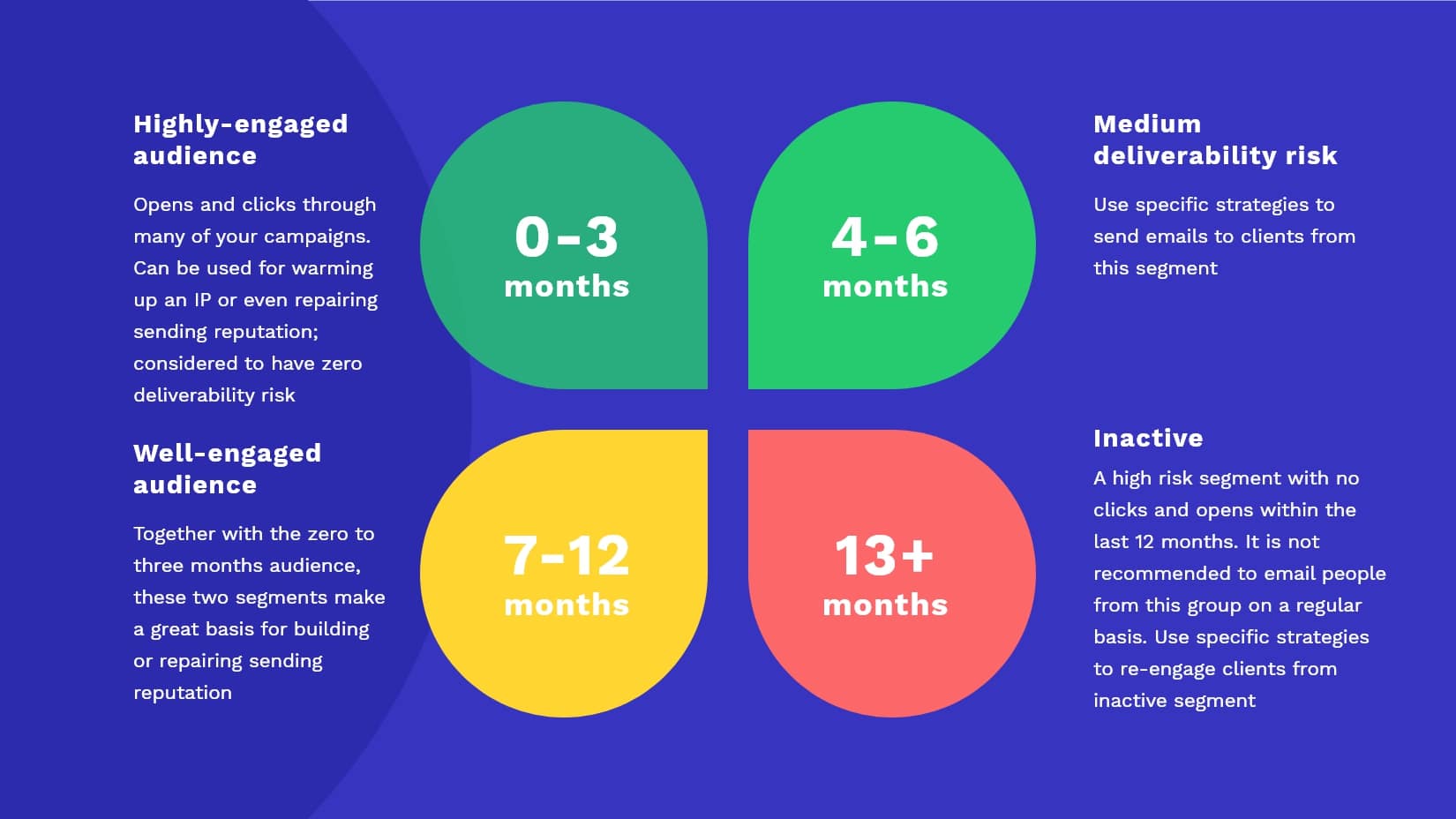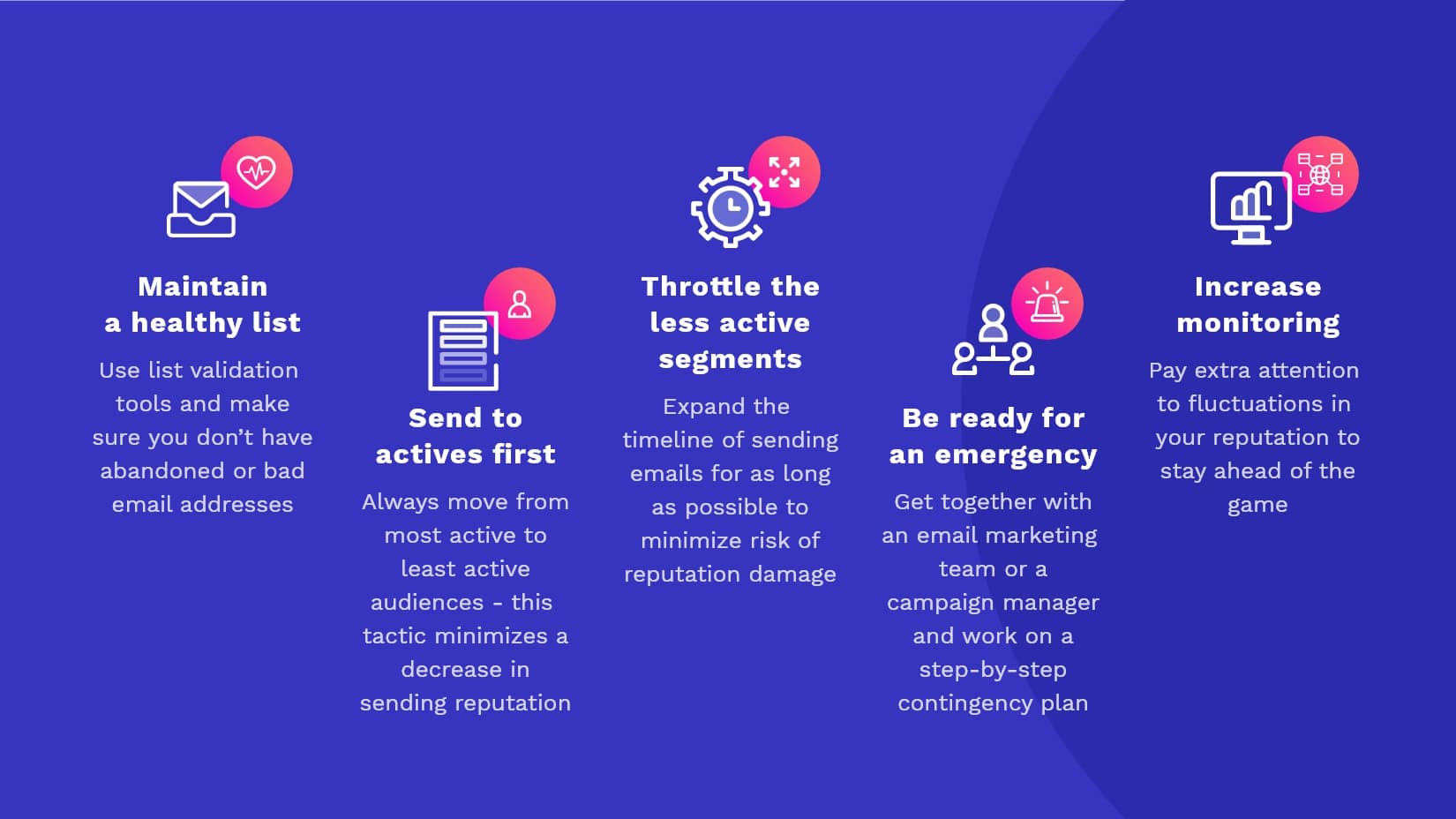Manage Sender Reputation & Boost Email Deliverability With Subdomains

As an email marketer, you can’t obsess too much over deliverability. You’ve already built a targeted email list and created helpful and topical content for your newsletter, but is this enough for a successful email campaign? What email deliverability result will you get?
Here we’ll review fundamentals you should already know and look at some advanced tactics on how to deal with more serious email marketing deliverability problems.
1. Deliverability and Reputation Basics
Before going deep, examine the knowledge of the basics.
Use Subdomains to Send Emails
Simply put, a subdomain is a branch of your main domain. Creating subdomains is especially useful if your company tends to send big volumes of emails, like automated confirmations or receipts. A subdomain looks like this:

People often underestimate the role of subdomains in keeping a proper email deliverability rate across every brand’s email. Moreover, subdomains are connected to overall email campaign efficiency.
The Importance of Subdomains
Subdomains bring structure to your email systems and secure your parent domain from getting blacklisted. They also help you pinpoint where any deliverability problems may be originating from and provide you with clear information on engagement rates from different types of emails.
Reasons to implement subdomains
- Sender reputation analysis
Having a well-structured subdomain system is perfect for analyzing breaches in sender reputation.
Since there are different subdomains for specific purposes, it is quite easy to narrow down the email deliverability problem and find particular emails that cause it.
- Protecting the parent domain and its reputation
Email marketing campaigns can go wrong for a variety of reasons. If mistakes happen on a subdomain, they will only affect this one particular subdomain leaving the parent domain’s reputation intact. If the emails marked as spam were sent from a parent domain, this can cause much bigger problems down the road, such as blacklisting. It will take time and effort to get back on track so it’s better not to put your entire parent domain at risk.
- Eliminating confusion around engagement rates
Each email category has its own engagement rate. For instance, support-based email, like a password change, a shipping notification, or a payment notification, will usually get a better engagement rate compared to a marketing email. If you use one domain to send both first-priority support messages and marketing messages, then chances are your support emails will land in spam folder, bringing their engagement rate down and customer frustration up.
If you aim at healthy emails with high deliverability, acquiring subdomains for your company is a ‘must’. The larger the business, the more important subdomains should be as part of your email marketing strategy.
Email Authentication Essentials
Email authentication, when enabled on both the sender’s and the receiver’s end, is an essential tool that protects from email spoofing and phishing. The main goal is to prove that the email received by the client was sent from the sender it states it was from.
The basic Simple Mail Transfer Protocol (SMTP) email communication protocol does not equip with this sort of protection, which is why domains use a combination of three additional protocols known as SPF, DKIM, and DMARC.
SPF stands for Sender Policy Framework; it is a protocol, which allows the recipient’s server to run a sender’s validation procedure while receiving an email. Domain with an SPF record is secured and forged emails that pretend to come from this particular sender will end up in the spam folder. Spammers are much less attracted to domains with SPF, therefore fewer spam messages are sent from this domain. A lower spam level reduces the risk of finding yourself in a blacklist, which increases the email deliverability rate for legitimate emails.
Read: How to Deploy SPF Email Authentication
Domain Keys Identified Mail (DKIM) is another protective email protocol that raises the deliverability level of your emails. It assigns a signature to an email as proof of a sender’s legitimacy and confirms that no malicious changes were made to an email in the process.
As well as the lack of SPF, the absence of an installed DKIM record will lead to a spam folder placement for the email.
The Domain-based Message Authentication, Reporting, and Conformance (DMARC) is an email authentication protocol that operates based on SPF and DKIM: it aligns the results of the two and makes the validation process harder for hackers to bypass with malicious intentions.
Read: Authenticate Emails with DMARC for Better Deliverability
DMARC Analyzer is the most effective mechanism of delivering emails to inboxes.
It enables you to:
- Increase email deliverability
- Stop spoofing and phishing attacks
- Secure your business and your clients from unsolicited contact
- Track suspicious activity
These email authentication tools are industry staples for a good reason – they work. If you aim to create a trustworthy brand with a good sender reputation and to deliver emails to clients’ inboxes, you must have these essentials in place as soon as possible.
Mailing List Essentials
Every email marketing professional’s primary goal is to grow their email list. It’s important, however, to double-check that these rules are always followed, in order to maintain a good sender reputation:
- use only opt-in email addresses
Send messages strictly after a person’s email confirmation, otherwise, it will automatically be considered spam.
It’s also good practice to send triggered ‘welcome’ messages to your newly opted-in subscribers to interest them at an early stage.
- consider implementing confirmed opt-ins
Confirmed opt-ins or double opt-ins are registration techniques where new subscriber verifies their contact data after subscribing to your newsletter. Confirmed opt-ins increase engagement rates and secure brands from void email addresses, spammers, and bots.
In no situation should brands buy email marketing lists. Following this emailing strategy is the easiest way to get caught into a spam trap or added to a blacklist.
Deliverability Tools
When checking email deliverability metrics, consider monitoring your reputation on each ISP individually. For example, your overall deliverability rate may be high but your delivery and engagement rate on Gmail may be much lower than on Microsoft. To solve the issue, we strongly encourage using:
- Google postmaster tools;
- Microsoft SNDS (for companies with a dedicated IP address);
- A highly-qualified third-party professional for reputation monitoring.
Don’t underestimate the tools provided by Google and Microsoft because they compile a large segment of the email hosting market share, and are free for everyone to work with. If you prefer having all your tools, insights, and analytics in one place, however, we would suggest using third-party apps like GlockApps to get the following core features:
- Inbox insights
- DMARC analytics
- IP reputation monitoring
- Domain checks
- Instant notifications for suspicious domain activity
2. Reputation: Building, Repairing, and Maintaining
The one really worrisome and impactful aspect of email marketing is sender reputation. Whether you are just starting to build the reputation of your brand, repairing it after being damaged, or wondering how to keep a good sending reputation, we have actionable tips here.
Customize Strategy for Each Internet Service Provider (ISP)
When developing an email marketing strategy, we strongly recommend taking into account the specific features of each Internet Service Provider (ISP) your customers are using. We often look at the overall sending metrics.
Although the overall deliverability rate might be high, behind it lies an undetected problem of a particular ISP, which sends your emails straight to spam. Every ISP has a different set of rules and different filtering algorithms meaning: if your strategy works for Yahoo! customers, doesn’t mean that it will perform well for Gmail recipients.
An efficient way to boost email deliverability rate is by implementing micro-segmenting as well as building email marketing campaigns on the foot of specifications of particular ISPs.
To raise a reputation and improve email deliverability and click-to-open rate, putting some time and work in micro-segmenting pays off in full.
How to Decide Which Metrics Matter the Most
With all the information email marketers receive from analytics, metrics, rates, and stats, possibly it will become challenging to outline the next steps in your marketing strategy. When you encounter this problem, the best decision will come after looking at the whole picture.
- Inbox placement
Inbox placement insights equip you with knowledge about the percentage of emails that reach the inbox, end up in spam folders or other tabs, and GlockApps Inbox Insights is an efficient tool for monitoring your inbox placement. In addition, after analyzing your email, the program shows possible risky content, reports your spam score, and suggests how to improve your email deliverability rate.
- Bounce rate
Email bounce rate is a metric that shows how every given ISP deals with your emails. Digging into this data will potentially help you find the reasoning behind your particular rate and whether you should re-engage customers, get rid of inactive subscribers, or switch to a different emailing technique. GlockApps Bounce tracker is a perfect tool for improving the mailing list’s health.
- Reputation status
Since ISPs assign a reputation status score to senders, it’s important to take advantage of their own tools, like Google Postmaster tools and Microsoft SNDS, to analyze these scores. For deeper study as well as for smaller ISPs, however, consider using a third-party tool like GlockApps IP Reputation Monitor to add your IP, look at its current status, and then decide on what steps to take next.
- Opens and clicks
These are crucial metrics for the email marketer. One thing is certain: when you detect a downward trend in opens and clicks – you have a complication. To gain a thorough insight into the state of your email marketing, you should look at all these metrics altogether.
Reasons to Use Engagement-Based Segmenting

There are many different options for emailing list segmenting, based on demographics, location, interest groups, and the role they play in building, repairing, and maintaining sender reputation.
Engagement-based segmentation categorizes mailing lists based on how often each client opens and clicks through the email. This technique grants you the possibility to target your most engaged audience members regularly and explore options to interest less active clients.
Talking about a period of engagement there are no hard rules on when the client goes from active to relatively active or inactive. Audiences are diverse and need to be adjusted over time. Meanwhile, we have some recommendations on where to start
- Zero to three months
This segment contains your highly engaged audience members who open and click through your every email campaign. These openers are helpful for warming up an IP or even repairing a reputation and are thought to have zero deliverability risk.
- Four to six months
This segment is still a well-engaged audience; together with the zero to three months audience, these two segments can make a great basis for building or repairing the reputation of a brand.
- Seven to twelve months
This segment is a medium deliverability risk. Brands are recommended to use specific strategies when sending emails to clients in this segment.
- Thirteen plus months audiences
This segment is considered inactive, clients have not clicked or opened any brand emails within the last 12 months; they’re a high-risk segment. The main obstacle is that marketers intend to save this segment to prevent the overall email list from shrinking but to have the general brand sending reputation high, it is not advised to message people from a high-risk group on a regular basis.
Of course, there are specific strategies to re-engage clients from an inactive segment. With engagement-based segmentation, email marketers can target specific audiences and create different marketing campaigns depending on clicks and opens. By mixing these audiences in different ratios, marketers can re-engage older clients without breaching their sending reputation.
Leveraging Segmented Audience to Boost the Reputation
With newly divided audiences, email marketers are ready to pursue three main goals: building a new brand’s sending reputation, repairing a company’s damaged sending reputation, or maintaining a brand’s sending reputation. Whichever goal you aim to achieve, be sure to include the following principles:
- To engage older audiences, always combine them with highly engaged clients on the basis of the highest average unique opens.
- Don’t just add up two lists, like 0-3 months openers with 13+ openers.
- Use ratios, for instance, 85% of the highly-engaged audience and 15% of the older clients; you can continue using this technique until you’ve re-engaged all inactive subscribers.
1. Building the reputation
Developing a strong email marketing sender reputation from zero needs IP warming as well. After adding a new IP to the account, follow an approach of a steady increase in the volume of emails sent, by engaging your audience from 0 to 12 months.
2. Reputation repair
If your sending reputation has been damaged for some reason, repairing it by simultaneously emailing to all of your segments won’t work. Do the following: regularly interact with your most active clients 0-3 months while adding 20% of the less active openers at the most.
3. Re-engagement
Once you have built or repaired your brand’s sending reputation, what’s left to do is maintain its good position. Keep the flow of re-engagement throughout the year steadily, rather than sending random big leaps and emergency pushes. Test different ratios to find one that works for you, for starters try 70-30%.
Can I email the whole list?
You can, but you absolutely should not.
However, there are emergencies when brands absolutely have to send an email to all of their clients because there is no other way to resolve the situation. This action can have some unpleasant consequences, like a bounce rate spike or a higher rate of spam placement, which will result in an overall reputation decrease. Therefore it’s important to take certain safety measures into account before considering sending an email to your entire list:

5 Steps for Emailing the Entire Database
1. Keep a healthy list
Use list validation tools and make sure you don’t have abandoned or bad email addresses.
2. Send to actives first
This is another reason to build engagement-based segments. Always move from most active to least active audiences to minimize a decrease in your sending reputation.
3. Throttle the less active segments
Unfortunately, you can’t work with less active segments just as easily as with highly-engaged. Ideally, you should expand the timeline of sending emails to as long as possible to minimize the risk of reputation damage. Implement a throttling strategy that works best for your situation.
4. Work on an emergency plan in advance
Get together with an email marketing team or campaign managers and to work on a step-by-step contingency plan in case you ever find yourself in a worst-case scenario.
5. Increase monitoring
In any unpredictable emergency situations, it is important to pay extra attention to fluctuations in your sender reputation to stay ahead of the game. Consider increasing the monitoring of your metrics for this period since you are sending more emails than usual.
Key Takeaways
Understand the basics of deliverability and reputation:
- Using subdomains is one of the easiest things you can implement to improve deliverability and sending reputation.
- Know your way around the safety protocols SPF, DKIM, and DMARC records.
- Use third party deliverability tools for a better and deeper analysis.
Although there are an unlimited number of metrics available, it is important to focus on the most essential ones first: Inbox placement, bounce rate, reputation status, and opens and clicks.
Treat each ISP differently because the strategy that works for one of them may fail for another.
Make engagement-based segmentation part of your email marketing strategy, it is a key to improving email deliverability and maintaining a great sending reputation.
Learn how to work with ratios of active and inactive clients, whether you want to warm up the IP, repair the reputation, or re-engage older audiences.



